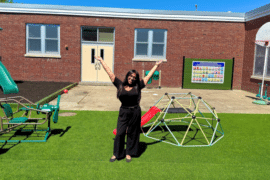Rediscovering Your Back to School Sleep Schedule
Ah, summer: precious late mornings, absent of blaring alarms; and those late, leisurely nights with no pre-dawn responsibilities pulling us to turn in early. These days are quickly coming to an end as a new school year rushes our way. My late summer morning and evening routines are literally hours apart from my early fall alarms and bedtimes, making it near impossible to just switch over when September comes along and demands it. This leaves me eyes wide open the night before school starts, and not just because my nerves and excitement are running wild with anticipation. When my calendar turns from August to September, I need to reset my internal sleep clock. Here are a few tricks I use to train my brain back into a school year sleep-wake schedule.
Melatonin is your friend
When the sun goes down, and the light of the day fades, our brain sends out a relaxing, sleepy feeling hormone into our bloodstream called melatonin. Melatonin’s mellowing affects encourage us to drift asleep, and its level remains elevated in our bloodstream for up to 12 hours, helping us to stay asleep. Sending these dreamy time messages to our bodies early can help to reset the body’s sleep clock when a normal pattern is disrupted (or, for us teachers, when we need to shift back into school mode). The reset button on your fall schedule is melatonin; all you need now is to learn how to turn it on when you need it!
Eating for sleep
Melatonin is released in response to natural darkness, and our natural wake/sleep patterns. To get our brains and bodies turning off earlier, start by getting plenty of sunlight and activity during the day. Since melatonin is not just made in our brains, we can also eat our way to a good night’s sleep. Melatonin is in almost every plant on Earth. So while your summer brain may not be telling you it’s time to get to bed, your dinner choices can! Obviously, once dinner time hits, avoid caffeine sources like teas and coffees that slow melatonin production. To keep that melatonin production pumping, start dinner with a spinach salad, garnished with tomatoes, cucumbers, and olives. Fatty fish (cod, salmon, halibut, tuna, trout, and snapper) is a great choice for a main dish, because it is full of tryptophan and B6, which raise serotonin levels needed to make melatonin.
For side dishes, rice is high in melatonin, and veggies carrying higher amounts of melatonin include corn, asparagus, Brussels sprouts, and broccoli. Go with fruit for dessert: tart cherries have more melatonin than ANY other food (sweet cherries have half the amount). Other fruits high in melatonin include strawberries, raspberries, pineapples, kiwis, pomegranates, and bananas. Bananas offer other sleep benefits because they contain magnesium, which helps relax muscles and nerves, and potassium, which can calm restless legs and help prevent leg cramps.
After dinner activity choices
After dinner, darken your environment, because even artificial lights will slow melatonin production. Stay away from stimulating video games, tablets, cell phone use, and TV which will slow melatonin production and potentially keep you up later. It’s time to start letting your body relax. Try some quiet music, reading, or a warm bath.
Snacks before bed?
Warm drinks can help us relax- and yes, there really is something to warm milk at bedtime, as the warmth soothes, and it contains our sleepy time friend, melatonin. Need a little snack? Tree nuts like pistachios, almonds, and walnuts are full of melatonin and magnesium (helps you relax) and also full of protein to keep your blood sugar stable while sleeping. Now, climb into your bed, adorned by your softest pajamas, and cuddle into your coziest of blankets, because being comfortable and warm (but not too warm) are crucial to falling and staying asleep. Have a good night, and a great new school year! Zzzzzzzzzz. Zzzzzzzzzzz. Zzzzzzzzzz.
Jessica Cicalese Kurtz is a wife, mother of 4, and veteran middle school engineering and science educator at Toms River Schools. She is an experienced curriculum developer, workshop creator, teacher trainer, and is a regular contributing writer for plymouthrockteachers.





